Strobist Boot Camp II: First Assignment - Author's headshot
David Hobby from Strobist.com has at last launched the 2nd season of the Boot Camp series.
For people who don't know what Strobist is, Strobist is a blog created by David Hobby in 2006. David Hobby was a photo-journalist at The Sun in Baltimore, USA. David was sharing his off-camera flash lighting techniques using small and portable flashguns instead of the heavy studio heads that photographers used to carry with them with the help of assistants. His teaching and photographic skills are such, he now have a worldwide community of fans. If you are interested to learn how to properly light your photographs, I strongly suggest you to go and read his Lighting 101 and Lighting 102.
"The Boot Camp is a series of assignments designed to help the newbs to get off their collective butt and actually go shoot something. If you are more experienced, you are more than welcome to participate. But understand that, at least at first, we'll be dialing the degree of difficulty back a little."
I've met Mark Hillary on Twitter recently, he has organized a Tweetup (Twitter Meetup) in Ealing and send an invitation to which I responded yes. Amongst the multiple roles he has, Mark is also a writter. As I needed a subject for this Strobist Boot Camp II first assignement, I've offered Mark to shoot an author's portrait for his next book "Talking Outsourcing". So there we went for a 2 hours session at his place.
As usual my lighting setup was composed of two light sources: my two Nikon SB-600. To give the book cover designer a bit of choice we decided to take the portraits with different backgrounds and feel. It was 8pm and the sun is low but the light was still there with a soft and slightly blue cast. For the first shot I've set a quarter CTO gel on one SB-600 at camera left to give a harsh rim light on the side of Mark's face and to reveal his dark suit and separate him from the background which was lit by the ambiance light only. A second SB-600 shooting thru a Westcott double fold white umbrella was the key light and positionned at camera right next to me. Playing with the CLS/TTL settings I up/down the flash compensation until I get the ratio I wanted on Mark's face. I controlled the light spill on the wooden wall at the back by having Mark step forward until the light from the umbrella flash fall off quickly and won't reach that wall. The rim flash was pointing in the opposite direction so wasn't contributing to the exposure of the background.
As always, when I see a brick wall I have to use it... can't help... So my next photograph will be a headshot against a brick wall. As the sun was going down on the other side of the house, the back garden was in the shade. And this is just excellent for flash photography as the ambiance light is dim enough to be over-powered by small flash units and allows you have more control on balancing your flash light with the ambiance.
The wall was in the shade, so you would expect the wall to be quite dark compared to the flash lit subject. If you look at the picture on the left, the top and bottom part of the background are darker than the middle. This is not a vignetting added in post-processing. It is just because I've put a DIY black straws grid spot on one of my SB-600 and positioned it camera right and very close to the wall and shooting 45 degrees downwards. The use of the grid spot gave me a very tight beam of light and the angle and position of the flash allowed me to shape the highlight on the brick wall. A quater CTO gel also helped to warm up that already warm brick wall.
In this picture the key light was again a SB-600 thru a white umbrella at camera left pointing down. I move it up and down, left and right until I get the spread of light and shadow I wanted. For the ratio, it's just a matter of trials and errors and chimping (check the LCD screen at the back of your camera).
We then went indoor to get a shot of Mark in front of his collection of books. Books are shiny so very reflective. I spent a lot of time positionning the flashes until I got rid of their reflection on the book covers which would have been distracting.
For this shot my key light was a DIY gridded one. But I started to build up my shadows with a shoot thru umbrella at camera right. This time for some reason the TTL sensor was fooled and my pictures were under exposed. So to be quick I set my flash settings to manual and dialed the power until I got what I wanted: a nice exposure on the books in the background but slightly under exposed.
I then set my gridded flashgun next to the umbrella straight in front of Mark to avoid any shadow cast on his face. As you can see there is now shadow on the side of his nose. This is the tip for using harsh light: have your subject look straight to the light then, if needed, ask them to look at you without moving their head and move your self if you need another angle.
The book on the bottom right was actually Mark's previous book "Who moved my job":
"This is a story about jobs and globalisation - with dogs!
When sheepdogs Winston, Charlie, and Blair find their idyllic life on an English farm disrupted by the arrival of lower-cost foreign herding dogs from India, China, and Poland they embark on an adventure that changes their lives forever. Who Moved My Job? follows these three Border Collies on an adventure through London where they are locked in a home for stray dogs, live rough in a cemetery, and meet a wise old Staffordshire Bull Terrier before eventually finding how to apply the skills they learned on the farm to life in the city."
I deliberately positionned the book there so that you can read its title but it is slightly hidden by Mark's face so won't seem too obvious.
The following picture was a test shot from the first setup with only the rim flash on. But I kind of like the result especially when processed in black and white.
See other Strobists work for this assignment here.
Tweet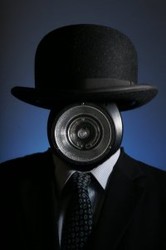
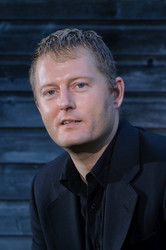
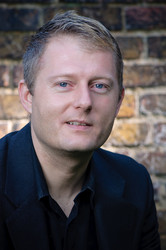
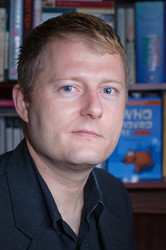
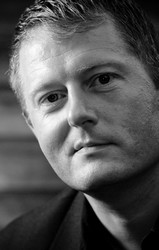
Comments